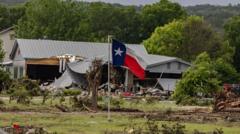In the wake of the Texas floods, a debate has arisen regarding whether cuts to the federal workforce have affected the National Weather Service's (NWS) ability to provide timely warnings. While the staffing reductions from the Trump administration have been noted, experts assert that the forecasters were adequately prepared for the event.
Texas Floods: Did Staffing Cuts Impact Weather Forecasting?

Texas Floods: Did Staffing Cuts Impact Weather Forecasting?
The role of government budget cuts in the accuracy of weather forecasting during the recent Texas floods comes under scrutiny.
In the aftermath of the devastating floods in Texas, some Democratic lawmakers have raised concerns that budget cuts during the Trump administration have adversely impacted the effectiveness of the National Weather Service (NWS). Senator Chris Murphy pointed out the importance of precise weather forecasting in preventing fatalities, suggesting that reduced staffing at the NWS may have hampered the timely prediction of the floods.
White House Press Secretary Karoline Leavitt countered these claims, asserting that NWS offices were adequately staffed. Despite the job losses attributed to efficiency initiatives under former President Trump, experts consulted by BBC Verify found that the NWS's capacity during the Texas floods appeared sufficient for the situation at hand.
The proposed federal cuts included a significant 25% reduction of the National Oceanic and Atmospheric Administration (NOAA) budget, which oversees the NWS, set to commence in the 2026 fiscal year. Although staffing at the NWS had already decreased due to an efficiency drive, this particular fiscal plan would not have directly influenced the Texas floods.
According to NWS union officials, around 600 employees were lost, representing a notable portion of their workforce. However, reports indicated that the forecasts and warnings issued during the flood event were consistent with standard practices. Avantika Gori, a civil and environmental engineering professor at Rice University, emphasized the inherent challenges in predicting localized extreme rainfall, suggesting that while staffing issues had implications, they were not determinative in this instance.
Experts like Daniel Swain from UCLA noted that while warnings were issued, the communication protocol could have been compromised due to staffing shortages in local offices. The NWS did acknowledge that both the San Antonio and San Angelo offices, covering areas severely impacted by the floods, had existing vacancies, particularly lacking a senior hydrologist and a meteorologist tasked with coordinating emergency communications.
Despite these concerns, officials maintained that additional staffing had been implemented in preparation for the flooding event. NWS meteorologists affirmed that the staffing adjustments during the disaster ensured timely and adequate warning dissemination.
Another area of contention has been the reduction in weather balloon launches. Meteorologist John Morales mentioned a cut of 20% in launches nationwide, leading some to speculate that this has inhibited forecasting capabilities. Nonetheless, NWS data confirmed that launches continued appropriately in areas near the flooding, suggesting that the weather data supporting forecasts remained robust.
As investigations continue, questions linger about the broader implications of budgetary allocations and staffing levels within the NWS. The focus remains on ensuring the effectiveness of weather forecasting agencies in safeguarding communities against future climatic challenges.





















